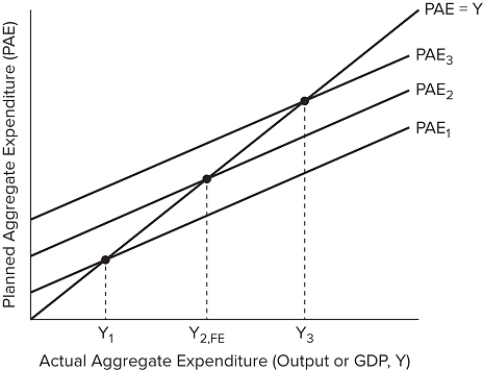A) $20,000
B) $2,500
C) $17,500
D) $18,000
Correct Answer

verified
Correct Answer
verified
Multiple Choice
In general, households with lower wealth tend to have a(n) _______ MPC relative to wealthier households.
A) lower
B) higher
C) similar
D) identical
Correct Answer

verified
Correct Answer
verified
Multiple Choice
The figure shows planned aggregate expenditure and output for an economy.  If output in this economy is Y1, there should be _______ in production because PAE is _______ actual output.
If output in this economy is Y1, there should be _______ in production because PAE is _______ actual output.
A) an increase; less than
B) an increase; greater than
C) no change; equal to
D) a decrease; greater than
Correct Answer

verified
Correct Answer
verified
Multiple Choice
The figure shows planned aggregate expenditure and output for an economy.  Suppose that the economy's output is Y2. This level of GDP would be considered:
Suppose that the economy's output is Y2. This level of GDP would be considered:
A) inflationary.
B) recessionary.
C) a long-run level of output.
D) unsustainable over time.
Correct Answer

verified
Correct Answer
verified
Multiple Choice
A(n) _______ relationship exists between expected future income and consumption.
A) negative
B) positive
C) indirect
D) constant
Correct Answer

verified
Correct Answer
verified
Multiple Choice
An inflationary output gap exists when the current level of output is _______ full employment GDP.
A) below
B) above
C) equal to
D) decreasing rapidly relative to
Correct Answer

verified
Correct Answer
verified
Multiple Choice
If spending increases by $200, and GDP increases by $1,000 as a result, what must the MPC be?
A) 0.80
B) 0.75
C) 4
D) 5
Correct Answer

verified
Correct Answer
verified
Multiple Choice
Which of the following scenarios would increase the net exports component of aggregate expenditure?
A) The dollar increases in value relative to other currencies.
B) Countries in the European Union experience a long period of economic growth.
C) A series of recalls for domestic automobiles shifts preferences towards foreign cars and trucks.
D) The United States experiences a long period of economic growth.
Correct Answer

verified
Correct Answer
verified
Multiple Choice
Suppose a housing bubble inflates house prices to new records. What will happen to overall consumption in this economy?
A) It will decrease.
B) It will stay the same.
C) It will increase.
D) The impact on consumption is unclear.
Correct Answer

verified
Correct Answer
verified
Multiple Choice
Which of the following does not influence autonomous spending?
A) Financial and housing wealth
B) Interest rates
C) Income
D) Export demand
Correct Answer

verified
Correct Answer
verified
Multiple Choice
If the MPC is 0.75, and the government cuts spending by $100 billion, the overall effect on GDP will be:
A) a decrease of $400 billion.
B) an increase of $250 billion.
C) a decrease of $250 billion.
D) an increase of $400 billion.
Correct Answer

verified
Correct Answer
verified
Multiple Choice
Which of the following describes the relationship between production and inventories?
A) If planned inventories are greater than actual inventories, firms should increase production.
B) If planned inventories are less than actual inventories, firms should decrease production.
C) If planned inventories are less than actual inventories, firms should increase production.
D) If planned inventories are greater than actual inventories, firms should decrease production.
Correct Answer

verified
Correct Answer
verified
Multiple Choice
When PAE is less than Y, inventories should:
A) increase.
B) decrease.
C) remain the same.
D) decrease slightly before sharply increasing.
Correct Answer

verified
Correct Answer
verified
Multiple Choice
The marginal propensity to consume:
A) is the amount by which consumption increases when after-tax income increases by $1.
B) is closely linked to the multiplier effect of government spending.
C) is a value between 0 and 1.
D) All of these are true.
Correct Answer

verified
Correct Answer
verified
Multiple Choice
Suppose Erin receives an inheritance worth $50,000. If her MPC is 0.75, how much of the additional $50,000 that Erin earns will be spent?
A) $50,000
B) $12,500
C) $37,500
D) $40,000
Correct Answer

verified
Correct Answer
verified
Multiple Choice
A(n) _______ relationship exists between profitability and investment spending.
A) negative
B) positive
C) indirect
D) constant
Correct Answer

verified
Correct Answer
verified
Multiple Choice
If the marginal propensity to consume is 0.25, it would mean that:
A) $0.25 of an additional $1 of individuals' after-tax income is spent on consumption.
B) $0.25 of an additional $1 of individuals' after-tax income is saved.
C) $0.75 of an additional $1 of individuals' after-tax income is spent on consumption.
D) None of these are true.
Correct Answer

verified
Correct Answer
verified
Multiple Choice
If the domestic income of a nation's citizens decreases, net exports will likely:
A) increase.
B) decrease.
C) remain constant.
D) There is not enough information to determine what will happen.
Correct Answer

verified
Correct Answer
verified
Multiple Choice
Which of the following is not an example of a transfer payment?
A) Social Security payments
B) Sales tax
C) Unemployment benefits
D) Workman's compensation
Correct Answer

verified
Correct Answer
verified
Multiple Choice
Which of the following scenarios would cause investment to increase?
A) The Federal Reserve announces an increase in the interest rate.
B) Housing prices increase.
C) A free trade agreement increases overall exports.
D) The U.S. government announces a plan to tax the ad revenue of large tech companies.
Correct Answer

verified
Correct Answer
verified
Showing 41 - 60 of 134
Related Exams